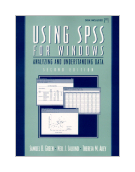Samuel
B. Green , University of Kansas
Neil J. Salkind , University of Kansas
Theresa M. Akey , Park Hill School District
Published
September 1999 by Humanities/Social Science
Copyright
2000, 430 pp. Paper Bound with Disk ISBN
0-13-020840-X
For
masters- and doctoral-level students in intro and advanced statistics.
This text
provides comprehensive treatment of all relevant topics for SPSS for Windows, including an
introduction to get users up and running plus extensive discussion of more complex topics
utilizing SPSS 9.0. Substantive information about statistical techniques includes a brief
discussion of each statistical technique, examples of how the statistic is applied, the
assumptions underlying the statistic, a description of the effect size, a sample data set
that can be analyzed, the research question associated with the data set, step-by-step
instructions as to how to complete the analysis, a discussion of the results of the
analysis, alternative analytic techniques when available and a visual display of the
results using SPSS graphic options.
NEW-Extensive
coverage of version SPSS 9.0.
Comprehensive
treatment of all relevant topics.
Step-by-step
descriptions of the most basic SPSS techniques divided into 17 lessons-Getting
Started, Creating and Working with Data Files, Working with SPSS data, and Working
with SPSS Charts and Outputs.
Step-by-step
procedures of statistical techniques-Includes examples and copious illustrations of
screen shots to enhance explanations throughout.
Student
disk-Provides all files needed to work through lessons in the book included with the
text.
Pedagogy-Tips
included in each lesson and chapter objectives.
I.
USING SPSS.
Unit 1:
Getting Started with SPSS. Lesson 1. Starting SPSS for Windows.
Lesson 2. The SPSS Main Menus and Toolbar.
Lesson 3. Using SPSS Help.
Lesson 4. A Brief SPSS Tour.
Unit 2:
Creating and Working with Data Files. Lesson 5. Defining Variables.
Lesson 6. Entering and Editing Data.
Lesson 7. Inserting and Deleting Cases and Variables.
Lesson 8. Selecting, Copying, Cutting and Pasting Data.
Lesson 9. Printing and Exiting an SPSS Data File.
Lesson 10. Exporting and Importing SPSS Data.
Unit 3: Working with Data. Lesson 11. Finding Values, Variables, and Cases.
Lesson 12. Recoding Data and Computing Values.
Lesson 13. Sorting, Transposing, and Ranking Data.
Lesson 14. Merging and Splitting Files.
Unit 4: Working with SPSS Charts and Output. Lesson 15. Creating an SPSS Chart.
Lesson 16. Enhancing SPSS
Charts.
Lesson 17. Using the Viewer.
II. WORKING WITH SPSS PROCEDURES.
Unit 5: Creating Variables. Lesson 18. Summarizing and Describing Data.
Lesson 19. Univariate Descriptive
Statistics for Qualitative Variables.
Lesson 20. Univariate Descriptive
Statistics for Quantitative Variables.
Unit 6: T Test Procedures. Lesson 21. One Sample T Test.
Lesson 22. Paired-Samples T Test.
Lesson 23. Independent-Samples T Test.
Unit 7: Univariate and Multivariate Analysis-of-Variance Techniques. Lesson 24. One-Way
Analysis of Variance.
Lesson 25. Two-Way Analysis of
Variance with Comments about Higher-Way Analysis of Variance.
Lesson 26. One-Way Analysis of
Covariance.
Lesson 27. One-Way Multivariate
Analysis of Variance.
Lesson 28. One-Way Repeated-Measures
Analysis of Variance.
Lesson 29. Two-Way Repeated-Measures
Analysis of Variance.
Unit 8: Correlation, Regression, and Discriminant Analysis Procedures. Lesson 30. The
Pearson Product-Moment Correlation Coefficient.
Lesson 31. Partial Correlations.
Lesson 32. Bivariate Linear
Regression.
Lesson 33. Multiple Linear Regression.
Lesson 34. Discriminant Analysis.
Unit 9: Scaling Procedures. Lesson 35. Factor Analysis.
Lesson 36. Internal Consistency Estimates of
Reliability.
Lesson 37. Item Analysis Using the
Reliability Procedure.
Unit 10: Nonparametric Procedures. Lesson 38. The Binomial Test.
Lesson 39. One-Sample Chi-Square Test.
Lesson 40. Two-Way Contingency Table Analysis
Using Crosstabs.
Lesson 41. Two Independent-Sample Tests: The
Mann-Whitney U Test.
Lesson 42. K Independent Samples Tests: The
Kruskal-Wallis and the Median Tests.
Lesson 43. Two Related-Samples Tests: The McNemar,
the Sign, and the Wilcoxon Tests.
Lesson 44. K Related Samples Tests: The Friedman
Test and the Cochran Test.
Appendix A: Data for Crab Scale and Teacher Scale.
Appendix B: Methods for Controlling Type 1 Error
across Multiple Hypothesis Tests.
Appendix C: Selected Answers to Lesson Exercises.
References.
Index.
Księgarnia nie działa. Nie odpowiadamy na pytania i nie realizujemy zamówien. Do odwolania !.


